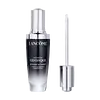Tula Skincare Triple-Hydra Complex Day & Night Serum Versus Lancôme Advanced Génifique Youth Activating Concentrate
What's inside
What's inside
 Key Ingredients
Key Ingredients

 Benefits
Benefits

 Concerns
Concerns

 Ingredients Side-by-side
Ingredients Side-by-side

Water
Skin ConditioningDipentaerythrityl Hexacaprylate/Hexacaprate
EmulsifyingPentaerythrityl Tetraisostearate
EmollientIsononyl Isononanoate
EmollientPropanediol
SolventGlycerin
HumectantCaprylic/Capric Triglyceride
MaskingSodium Hyaluronate
HumectantHydrolyzed Hyaluronic Acid
HumectantSodium Hyaluronate Crosspolymer
HumectantHydrolyzed Sodium Hyaluronate
Skin ConditioningSodium Acetylated Hyaluronate
HumectantSodium Polyglutamate
HumectantSqualane
EmollientCollagen
MoisturisingLactococcus Ferment Lysate
Skin ConditioningLactobacillus Ferment
Skin ConditioningLactobacillus
Skin ConditioningBeta Vulgaris Root Extract
Skin ConditioningCurcuma Longa Root Extract
MaskingPyrus Malus Fruit Extract
Skin ConditioningCitrullus Lanatus Fruit Extract
Skin ConditioningVaccinium Angustifolium Fruit Extract
Skin ProtectingLens Esculenta Fruit Extract
Skin ConditioningHydrolyzed Rice Protein
Skin ConditioningInulin
Skin ConditioningAlpha-Glucan Oligosaccharide
CleansingLactic Acid
BufferingSodium PCA
HumectantHydrogenated Poly(C6-20 Olefin)
AbrasiveHydroxyacetophenone
AntioxidantLeuconostoc/Radish Root Ferment Filtrate
AntimicrobialPolymnia Sonchifolia Root Juice
Skin ConditioningRhus Verniciflua Peel Wax
Caprylyl Glycol
EmollientSodium Lactate
BufferingCarrageenan
Pentylene Glycol
Skin ConditioningMaltodextrin
AbsorbentButylene Glycol
HumectantSodium Chloride
MaskingEthylhexylglycerin
Skin Conditioning1,2-Hexanediol
Skin ConditioningAcrylates/C10-30 Alkyl Acrylate Crosspolymer
Emulsion StabilisingTromethamine
BufferingHdi/Trimethylol Hexyllactone Crosspolymer
Sodium Benzoate
MaskingPotassium Sorbate
PreservativeWater, Dipentaerythrityl Hexacaprylate/Hexacaprate, Pentaerythrityl Tetraisostearate, Isononyl Isononanoate, Propanediol, Glycerin, Caprylic/Capric Triglyceride, Sodium Hyaluronate, Hydrolyzed Hyaluronic Acid, Sodium Hyaluronate Crosspolymer, Hydrolyzed Sodium Hyaluronate, Sodium Acetylated Hyaluronate, Sodium Polyglutamate, Squalane, Collagen, Lactococcus Ferment Lysate, Lactobacillus Ferment, Lactobacillus, Beta Vulgaris Root Extract, Curcuma Longa Root Extract, Pyrus Malus Fruit Extract, Citrullus Lanatus Fruit Extract, Vaccinium Angustifolium Fruit Extract, Lens Esculenta Fruit Extract, Hydrolyzed Rice Protein, Inulin, Alpha-Glucan Oligosaccharide, Lactic Acid, Sodium PCA, Hydrogenated Poly(C6-20 Olefin), Hydroxyacetophenone, Leuconostoc/Radish Root Ferment Filtrate, Polymnia Sonchifolia Root Juice, Rhus Verniciflua Peel Wax, Caprylyl Glycol, Sodium Lactate, Carrageenan, Pentylene Glycol, Maltodextrin, Butylene Glycol, Sodium Chloride, Ethylhexylglycerin, 1,2-Hexanediol, Acrylates/C10-30 Alkyl Acrylate Crosspolymer, Tromethamine, Hdi/Trimethylol Hexyllactone Crosspolymer, Sodium Benzoate, Potassium Sorbate
Water
Skin ConditioningBifida Ferment Lysate
Skin ConditioningGlycerin
HumectantAlcohol Denat.
AntimicrobialDimethicone
EmollientHydroxyethylpiperazine Ethane Sulfonic Acid
BufferingAscorbyl Glucoside
AntioxidantSodium Hyaluronate
HumectantSodium Hydroxide
BufferingSodium Benzoate
MaskingPhenoxyethanol
PreservativeAdenosine
Skin ConditioningFaex Extract
Skin ConditioningPEG-20 Methyl Glucose Sesquistearate
EmulsifyingPEG-60 Hydrogenated Castor Oil
EmulsifyingSalicyloyl Phytosphingosine
Skin ConditioningAmmonium Polyacryloyldimethyl Taurate
Emulsion StabilisingLimonene
PerfumingXanthan Gum
EmulsifyingCaprylyl Glycol
EmollientDisodium EDTA
Octyldodecanol
EmollientCitronellol
PerfumingParfum
MaskingWater, Bifida Ferment Lysate, Glycerin, Alcohol Denat., Dimethicone, Hydroxyethylpiperazine Ethane Sulfonic Acid, Ascorbyl Glucoside, Sodium Hyaluronate, Sodium Hydroxide, Sodium Benzoate, Phenoxyethanol, Adenosine, Faex Extract, PEG-20 Methyl Glucose Sesquistearate, PEG-60 Hydrogenated Castor Oil, Salicyloyl Phytosphingosine, Ammonium Polyacryloyldimethyl Taurate, Limonene, Xanthan Gum, Caprylyl Glycol, Disodium EDTA, Octyldodecanol, Citronellol, Parfum
 Reviews
Reviews

Ingredients Explained
These ingredients are found in both products.
Ingredients higher up in an ingredient list are typically present in a larger amount.
Caprylyl Glycol is a humectant and emollient, meaning it attracts and preserves moisture.
It is a common ingredient in many products, especially those designed to hydrate skin. The primary benefits are retaining moisture, skin softening, and promoting a healthy skin barrier.
Though Caprylyl Glycol is an alcohol derived from fatty acids, it is not the kind that can dry out skin.
This ingredient is also used as a preservative to extend the life of products. It has slight antimicrobial properties.
Learn more about Caprylyl GlycolGlycerin is already naturally found in your skin. It helps moisturize and protect your skin.
A study from 2016 found glycerin to be more effective as a humectant than AHAs and hyaluronic acid.
As a humectant, it helps the skin stay hydrated by pulling moisture to your skin. The low molecular weight of glycerin allows it to pull moisture into the deeper layers of your skin.
Hydrated skin improves your skin barrier; Your skin barrier helps protect against irritants and bacteria.
Glycerin has also been found to have antimicrobial and antiviral properties. Due to these properties, glycerin is often used in wound and burn treatments.
In cosmetics, glycerin is usually derived from plants such as soybean or palm. However, it can also be sourced from animals, such as tallow or animal fat.
This ingredient is organic, colorless, odorless, and non-toxic.
Glycerin is the name for this ingredient in American English. British English uses Glycerol/Glycerine.
Learn more about GlycerinSodium Benzoate is a preservative. It's used in both cosmetic and food products to inhibit the growth of mold and bacteria. It is typically produced synthetically.
Both the US FDA and EU Health Committee have approved the use of sodium benzoate. In the US, levels of 0.1% (of the total product) are allowed.
Sodium benzoate works as a preservative by inhibiting the growth of bacteria inside of cells. It prevents the cell from fermenting a type of sugar using an enzyme called phosphofructokinase.
It is the salt of benzoic acid. Foods containing sodium benzoate include soda, salad dressings, condiments, fruit juices, wines, and snack foods.
Studies for using ascorbic acid and sodium benzoate in cosmetics are lacking, especially in skincare routines with multiple steps.
We always recommend speaking with a professional, such as a dermatologist, if you have any concerns.
Learn more about Sodium BenzoateSodium Hyaluronate is hyaluronic acid's salt form. It is commonly derived from the sodium salt of hyaluronic acid.
Like hyaluronic acid, it is great at holding water and acts as a humectant. This makes it a great skin hydrating ingredient.
Sodium Hyaluronate is naturally occurring in our bodies and is mostly found in eye fluid and joints.
These are some other common types of Hyaluronic Acid:
Learn more about Sodium HyaluronateWater. It's the most common cosmetic ingredient of all. You'll usually see it at the top of ingredient lists, meaning that it makes up the largest part of the product.
So why is it so popular? Water most often acts as a solvent - this means that it helps dissolve other ingredients into the formulation.
You'll also recognize water as that liquid we all need to stay alive. If you see this, drink a glass of water. Stay hydrated!
Learn more about Water